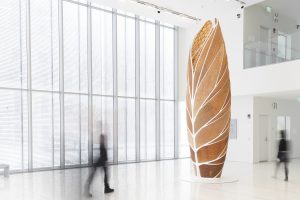

Neri Oxmann and MIT, in this project, explore the intersection of biomimetics, digital fabrication, and material properties. Bio-composites, cellulose, chitosan, and pectin, which are among some of the most abundant organic materials, are digitally fabricated to dynamically respond to changes in heat and humidity. There is an interesting relationship between digital and computational processes and highly organic matter that both intersect to develop something that is neither clearly computational nor organic. However, it is clear that the use of such techniques allows for an architecture that is deeply engaged with natural conditions. Although the process that creates the artifact is highly calibrated and computational, the result is something that, as a system, behaves and performs like an organic structure. A challenge of this process seems to be quantifying and measuring that which is highly nuanced: natural materials. Many systems in nature are highly complex, and the implementation of digital fabrication techniques into such nuanced systems could prove to be difficult.
![[OLD FALL 2019] 15-104 • Introduction to Computing for Creative Practice](wp-content/uploads/2020/08/stop-banner.png)